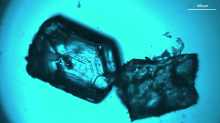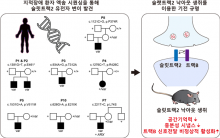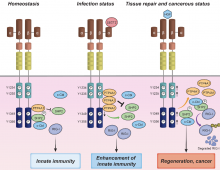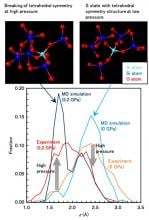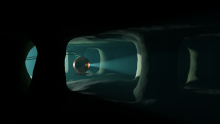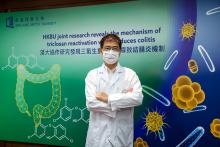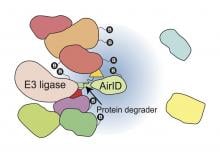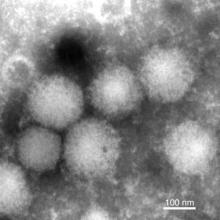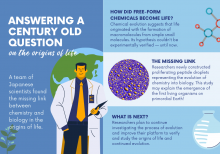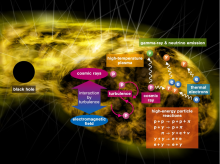Nature Communications
News
18 Oct 2022
Hydrogen, a clean fuel, is incredibly dense in energy—three times more than diesel or gasoline. Its ability to power a sustainable future has been hindered by a lack of high performing catalysts. Now, a collaborative research group has developed nanoporous molybdenum-based intermetallic compounds that could address this conundrum.
14 Oct 2022
Researchers from Osaka University have developed a computational analysis tool called CAPITAL for comparative analysis of single-cell RNA sequencing data with complicated branching trajectories. As cells undergo a dynamic process, they can be placed on a “pseudotime trajectory” to analyze the gene expression changes throughout the process. While previously only straightforward linear trajectories could be compared, CAPITAL is proven to be able to accurately compare branching trajectories, significantly advancing the field of high-throughput single-cell sequencing.
06 Oct 2022
Researchers from Osaka University have found that serum albumin interferes with β2m amyloid fibril formation through macromolecular crowding. Monitoring serum albumin concentrations could therefore help prevent patients from developing dialysis-related amyloidosis, a serious complication of long-term dialysis.
30 Sep 2022
Researchers from Osaka University revealed that the surface electronic structure of topological insulators varies according to its surface atomic structure, even though it was believed to have been protected by the symmetry of the electronic structure inside the crystal and is therefore unaffected by differences in surface atomic structure. This work offers a new means of minimizing the power consumption and increasing the speed of next-generation technology.
27 Sep 2022
- The low-cost, high-energy, long-life lithium-sulfur battery is based on a novel silica/sulfur interlayer.
- The battery is expected to be used in next-generation mobile phones, drones, and electric vehicles owing to its high energy density and improved lifespan.
26 Sep 2022
Hokkaido University researchers find a new way of producing the industrially important propylene that is more energy efficient than existing approaches—and in the process turns carbon dioxide into another usable resource. Their pioneering catalyst design thus contributes to the carbon neutralization of the petrochemical industry.
22 Sep 2022
A pathway that malfunctions in advanced non-alcoholic fatty liver disease could be fixed with the aid of spermidine, a compound naturally found in bodily cells and certain whole foods.
20 Sep 2022
The activity of deep-focus earthquakes, which increases with depths from ~400 km to a peak at ~600 km, is enigmatic because conventional brittle failure is unlikely to occur at elevated pressures. Our experiments showed that formation of thin weak layers filled with nano-crystalline olivine/wadsleyite, upon the pressure-induced phase transition of olivine, is the major cause of deep-focus earthquakes on the metastable olivine wedge in deep slabs.
15 Sep 2022
Researchers develop a new integrated framework that factors in the many variables relevant to accurate carbon emissions modeling in the transportation sector, allowing for policymakers to choose the best path to achieve carbon neutrality.
12 Aug 2022
Rare earth metals, when linked, can act as a conduit for energy flow, and show promise for the development of novel materials.
10 Aug 2022
- Joint research team of DGIST Professor Um Ji-won and Professor Ko Jae-won discovered several SLITRK2 synaptic adhesion gene mutations related to intellectual disabilities
- Identified the abnormal pattern in the signaling mechanism of SLITRK2 and presented a new therapeutic biomarker
08 Aug 2022
Scientists from the Institute of Industrial Science, The University of Tokyo, demonstrate that accounting for liquid preordering is essential to predicting crystal growth

15 Jul 2022
A team co-led by a City University of Hong Kong (CityU) neuroscientist has identified a key mechanism of a biological clock that ensures roundworms stay regular by defecating at steady intervals.
05 Jul 2022
Innate immunity is activated when the pattern recognition receptors (PRRs) recognize pathogen-associated molecular patterns (PAMPs). We show that a liver-derived secretory protein LECT2, a hepatokine, binds to the HGF receptor MET, a proto-oncogene product, to suppress the proliferation signal of MET. LECT2 activates retinoic acid-inducible gene-I, enhancing antiviral and innate immune responses through MET. Thus, LECT2 is an anti-proliferative and immunoregulatory factor that could be a therapeutic target for viral infections and cancer.
27 Jun 2022
Understanding the structural origin of the anomalous properties of SiO2 liquid and glass is of great interest in a wide range of scientific fields. The fraction of the S state with tetrahedral symmetry structure is considered to be the controlling parameter of the anomalous properties of SiO2 liquid in theoretical studies. However, it has not been well identified in experiments. In this work, we find experimental evidence of tetrahedral symmetry breaking in SiO2 glass under pressure.
23 May 2022
Tetraphenylammonium, with all four hydrogens of ammonium (NH4+) replaced with benzene rings, has neither been discovered in nature nor chemically synthesized, calling into question whether it could exist. Here, we succeeded in synthesizing tetraphenylammonium for the first time, demonstrating its stable existence. The synthetic strategy used in this study, radical coupling, may be applicable to the synthesis of various related ammoniums with high structural novelty.
19 May 2022
Structural color printing creates new pathways for medical diagnostics and miniaturized sensors
03 May 2022
A Hong Kong Baptist University (HKBU) collaborative research study has revealed that certain gut microbial enzymes mediate the reactivation of triclosan (TCS) from its inactive glucuronide metabolite. TCS is an antimicrobial agent commonly used in a wide range of consumer products, and it is associated with the development of colitis.
06 Apr 2022
Osaka City University* study suggests memories are formed through an integration across brain regions via burst activity in amygdala-prefrontal neuronal ensembles during memory acquisition, and then hippocampal-prefrontal synchrony during post-experience sleep. (Osaka City University has now changed its name as Osaka Metropolitan University)
04 Apr 2022
Scientists have found a common substance that can reversibly and rapidly store and release relatively large amounts of low-grade heat without decomposing. The research could lead to more efficient reuse of industrial waste heat.
09 Mar 2022
An analysis method for protein–protein interactions using proximity-dependent biotinylation for next-generation drugs
14 Dec 2021
A prototype MRI machine that can be built at low cost and produces high quality neuroimaging is reported in Nature Communications. The machine can help provide access to MRI across low- and middle-income countries, as well as at the point of care.
07 Dec 2021
Scientists at Hokkaido University and Texas A&M University have identified a key mechanism used by the SARS-CoV-2 virus to evade host immune systems.
18 Nov 2021
A new method for creating one of chemistry’s most widely used class of compounds could revolutionize industrial processes, making them cheaper, simpler and more environmentally friendly.
21 Oct 2021
An international research team has discovered a monolayer Mott insulator that has strong heat and light resistance. The breakthrough potentially paves the way for realizing the control needed to induce superconductivity at room temperature.
13 Oct 2021
The El Niño Southern Oscillation (ENSO) could impact child nutrition in many countries in the tropics, a new study in Nature Communications suggests.
04 Oct 2021
A previously unknown virus that can infect humans and cause disease has been identified by scientists in Japan. The novel infectious virus, named Yezo virus and transmitted by tick bites, causes a disease characterized by fever and a reduction in blood platelets and leucocytes.
27 Sep 2021
The missing link isn’t a not-yet-discovered fossil, after all. It’s a tiny, self-replicating globule called a coacervate droplet, developed by two researchers in Japan to represent the evolution of chemistry into biology.
24 Sep 2021
Energetic particles are ubiquitous across the universe but their origins are unexplained. Now, a research team has proposed that mellow black holes act as the source of high-energy cosmic particles.
Events
Sorry, no events coming up for this topic.
Researchers
Sorry, no researchers coming up for this topic.
Giants in history
Sorry, no researchers coming up for this topic.


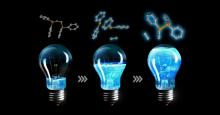

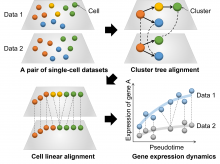

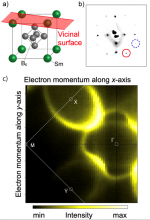
![[Figure 1] Comparison of the lithium-sulfur battery incorporating the porous silica/sulfur interlayer developed here with a lithium-sulfur battery prepared using a conventional conductive interlayer or polar interlayer.](https://www.asiaresearchnews.com/sites/default/files/styles/medium/public/articles_images/3.%20Photographic%20data%20related%20to%20research%20results.png?itok=SVnYo7fI)




